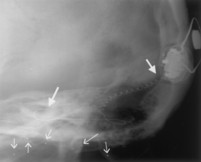 |
The Bionic Ear
By Dr. Joseph Skufca
For most of us, our sense of hearing is taken for granted. Certainly,
we could sit in a sound proof booth and sense no sound, but we are
probably unable to really imagine what it would be like to have NEVER
heard sound. Our thoughts and ideas are centered around our language,
which is auditory/verbal – we think in words. Although many
people in the deaf community lead successful and fulfilling lives
without the sense of hearing, they now have an option. Research,
started in the 1950s, led to development of a device called a cochlear
implant (CI) – a bionic ear which can often restore hearing
sensation to people with severe or profound hearing loss.
 |
Computed Radiography of a cochlear implant - the
bionic ear. (Photo courtesy of Radiology) Researchers
use advanced mathematics to precisely locate the
implant device. [Whiting B, Bae K, Skinner M. Cochlear
implants:three-dimensional localization by means
of coregistration of CT and conventional radiographs. Radiology
2001;221:543-549]. To learn more about
the mathematics of medical imaging, visit here.
|
The first commercial implants were available in the 1970s, with
FDA approval coming in 1984. Although the initial devices were crude
in capability (subjects were only able to develop limited capability
to recognize a few words) the rapid advances in Digital Signal Processing
(DSP) have made these implants capable of providing many users with
the ability to recognize words, hold conversations, and even talk
on the phone. This “miracle of modern medicine” was made
possible through interdisciplinary efforts from the fields of medicine,
biology, material science, bioengineering, electrical engineering,
and mathematics. This installment of “Why Do Math” will
focus on the mathematical underpinnings of DSP, and in particular,
the mathematical miracle of the Fast Fourier Transform (FFT).
Find out more about Cochlear Implants.
|
About the Author
Joseph D. Skufca, Assistant Professor, Division of Mathematics
and Computer Science at Clarkson University
 Joseph
D. Skufca is an Assistant Professor in the Division of Mathematics and Computer
Science at Clarkson University, Potsdam, New York. His research focus
is dynamical systems, chaos, control, networks, and dynamics on networks. His
B.S. degree is from the United States Naval Academy (1985). He served
as a submarine officer in the United States Navy before retiring in 2005. He
earned his PhD in Applied Mathematics from University of Maryland, College
Park. His daughter, Julianna, received a cochlear implant in 2004. Joseph
D. Skufca is an Assistant Professor in the Division of Mathematics and Computer
Science at Clarkson University, Potsdam, New York. His research focus
is dynamical systems, chaos, control, networks, and dynamics on networks. His
B.S. degree is from the United States Naval Academy (1985). He served
as a submarine officer in the United States Navy before retiring in 2005. He
earned his PhD in Applied Mathematics from University of Maryland, College
Park. His daughter, Julianna, received a cochlear implant in 2004.
WEB: http://people.clarkson.edu/~jskufca/
CONTACT: jskufca@clarkson.edu
|
|
 |
|
|





